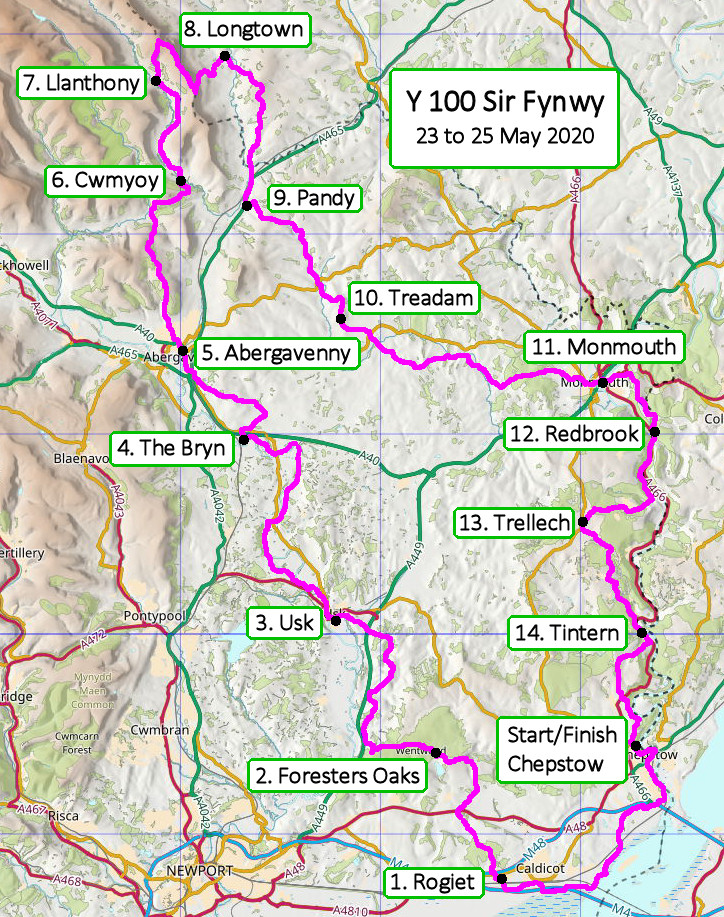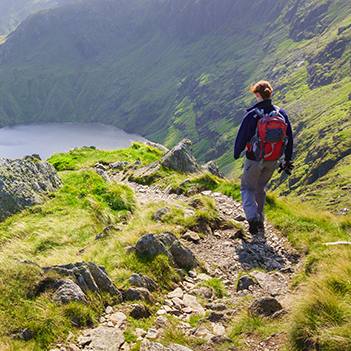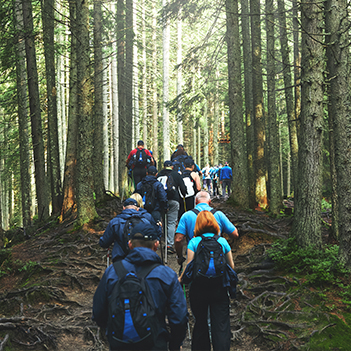Y 100 Sir Fynwy - Route Overview

Mapped using WayMaps from The Hug - Copyright © 2011-2019. Terms of use
Section 1 – Chepstow to Rogiet.
Section 1 of Y 100 Sir Fynwy sees the route leave Chepstow and walk to Rogiet via the Wales Coast Path.
The route leaves the school and turns left into The Dell and passes beneath the imposing Norman Chepstow Castle to reach a ‘bucket drop’ in the Drill Hall Car Park. The route will pass St Mary’s Church with its well preserved Norman west door arch and cross the A48 via an underpass. A short stretch of street walking will take the route out of Chepstow town centre and it will pass underneath the M48 as it leaves Chepstow via the Wales Coast Path which will be followed until Rogiet.
The route will pass through Mathern, the burial place of King Tewdric, St. Pierre Golf Club, St. Pierre Pill that was used as an important harbour in post Roman Britain, Black Rock that was used as the terminus for train passengers who would then cross the Severn Estuary via the ferry and Sudbrook which hosts the Severn Railway Tunnel pumping station and pumps out 50 million litres of water per day to prevent the tunnel flooding. The route will cross the M4 twice, once by passing underneath the Prince of Wales bridge and later by crossing via a footbridge and after 11.2 miles the route will arrive at Checkpoint 1 in Rogiet Community Church Hall.
Section 2 – Rogiet to Foresters Oaks Car Park.
Section 2 of Y 100 Sir Fynwy sees the route leave Rogiet and the Wales Coast Path and now join the Monmouthshire Way to reach Foresters Oaks Car Park.
The route leaves Rogiet and starts to head north into Slade Woods along the Monmouthshire Way. Some lane and field walking will bring the route to the Domesday registered village of Llanvair Discoed. The route will pass the impressive 17th century Court House and its quirky windows prior to the climb to Gray Hill via the Penhein Estate. The views from Gray Hill are particularly impressive and the Cotswolds, the Mendips, the Brecon Beacons National Park, the Severn Estuary as well as the conurbations of Newport and Cardiff can all be seen from this relatively small hill. A short but steep descent will see the route arrive at Checkpoint 2 in the Foresters Oaks Car Park after 6.4 miles.
Section 3 – Foresters Oaks Car Park to Usk.
Section 3 of Y 100 Sir Fynwy sees the route continue to follow the Monmouthshire Way and for some of the journey, the Usk Valley Way on undulating terrain to the Roman town of Usk.
Y 100 Sir Fynwy now enters the ancient forest of Wentwood and rises gently before descending via Bertholey House towards Newbridge on Usk. Bertholey House has its origins in the 16th century and was burnt down in 1905. It was restored to its current glory in 1999. The route passes its magnificently ornate gates and then climbs to Cefn Hill. The route provides fine views to the west Mynydd Maen, the first of the ridges that Valleys 100 followed in 2014. Gwern Hill is climbed prior to descending to Llewellyn’s Dingle and a long descent brings the route into Usk. Passing the west door of the Priory Church of St Mary, our entrants will pass the grave of St David Lewis who was executed for his Roman Catholic beliefs. A short street walk will see the route arrive at the Centenary Hall, Usk after 9.8 miles.
Section 4 – Usk to The Bryn
Section 4 of Y 100 Sir Fynwy follows the Usk Valley Way on a fairly level section to the riverside village of The Bryn.
The route continues to head north and for the first half of the section, the western bank of the River Usk is followed to the Chain Bridge that was built in 1829. The eastern side of the river bank is then followed to pass close to the estate of Clytha Castle prior to reaching The Bryn Village Hall after 10.2 miles.
Section 5 – The Bryn to Abergavenny
Section 5 of Y 100 Sir Fynwy leaves the Usk Valley Walk and enters an area that is relatively un-walked prior to arriving in Abergavenny, the gateway to the Black Mountains.
Leaving The Bryn, lanes are followed, principally because the footpaths that are shown on the map do not work, to Tresaison (which translates as trespasses!). Arable fields are followed to reach Highmead Farm and shortly afterwards the A465 is crossed and immediately afterwards the Abergavenny to Hereford main line. Road walking brings the route to The Guide Hall, Abergavenny after 5.6 miles. For those who have walked the Abergavenny Three Peaks, you’ll recognise the hall as the event Walk HQ.
Section 6 – Abergavenny to Cwmyoy
Section 6 of Y 100 Sir Fynwy leaves Abergavenny and climbs the Deri, one of Sugar Loaf’s southern ridges prior to descending to Cwmyoy.
The route leaves Abergavenny by walking steeply up Pen-y-Pound. Most of the climbing is done on the very quiet lane that brings the route to the ancient oak woodland of Twyn-yr-allt. More climbing through the woods sees the route emerge onto the open hillside of Deri. Heading in a northerly direction the route reaches 400 metres above sea level and re-joins the Monmouthshire Way before dropping down to Forest Coal Pit. The route skirts to the south of the ancient hillfort of Twyn y Gaer and after a short descent, after 6.6 miles arrives at Cwmyoy Memorial Hall.
Section 7 – Cwmyoy to Llanthony
Section 7 of Y 100 Sir Fynwy is a valley floor walk along the magnificent Vale of Eywas.
Leaving Cwmyoy Memorial Hall, the route passes close to St. Martin’s Church, famous for its twisted shape due to the pressure of the land slippage above it. You probably won’t see it as this section is likely to be dark for most entrants, but it’s worth a visit if you get the chance. The route follows a well-established path via several fields to reach Treats Campsite, Llanthony after 4.3 easy miles.
Section 8 – Llanthony to Longtown
Section 8 of Y 100 Sir Fynwy has the steepest and largest climb on the whole route. The reward will be fabulous views, particularly for the slower entrants as well as breakfast at Longtown.
The route now leaves the Monmouthshire Way and passes to the side of the iconic Augustinian Llanthony Priory that was dissolved by Henry VIII in 1538. If it’s dark when you’re here, look to the skies as this is a dark sky area and the stars will very bright. The route will see entrants ‘gird their loins’ as they climb steeply to Loxidge Tump and to reach the Offa’s Dyke Path at 604 metres above sea level. The route turns south and follows the very well established Offa’s Dyke path to its junction with the Beacons Way prior to turning east (and leaving Offa’s Dyke Path) and descending steeply during a brief foray into Herefordshire to Longtown which will be reached after 5.6 miles. Here entrants will enjoy a full Welsh Breakfast.
Section 9 – Longtown to Pandy
Section 9 of Y 100 Sir Fynwy heads south to Pandy on paths that provide a remarkable view south towards Ysgyryd Fawr.
The route leaves Longtown and immediately starts a 160 metre climb to Mynydd Ferddin. Once at the top, the route provides exceptional views to the south and east and passes close to Walterstone Motte and Bailey. A road walk of about a mile brings the route to the village of Pandy and after 5.6 miles the Pandy Village Hall is reached.
Section 10 – Pandy to Treadam
Section 10 of Y 100 Sir Fynwy sees the route join Offa’s Dyke path on which it remains for 20.5 miles.
The route leaves Pandy on the Offa’s Dyke Path and follows this well-established national trail via fields to reach Llangattock Lingoed. From here the route heads south to Caggle Street prior to rising to White Castle, one of the three Monmouthshire castles that are linked together to create the Three Castles Walk, and a favourite place for Rudolph Hess to visit when he was imprisoned in Wales during the Second World War. A short descent from White Castle brings the route to Treadam after 6.6 miles.
Section 11 – Treadam to Monmouth
Section 11 of Y 100 Sir Fynwy is a long section and sees the route end at Monmouth, a major Monmouthshire town. On route, it follows the Offa’s Dyke national trail.
The route leaves Treadam and follows rather remote paths that provide fine views of the surrounding countryside. Llantilio Crossenny is passed on route to the Bulmers’ apple orchard at Penrhos Farm. The beautiful church of Llanvihangel-Ystern-Llewen is visited and it is likely that a drinks point will be located here. A climb into Kings Wood follows prior to descending into the beautiful town of Monmouth. After 10.5 miles the route will arrive at the Hitchcock Sports Pavilion which is owned by the Monmouth School.
Section 12 – Monmouth to Redbrook
Section 12 of Y 100 Sir Fynwy is the shortest section on the whole route. It has a climb though, and views west from the Kymin will be impressive.
The last 18 miles of Y 100 Sir Fynwy are undulating. This section contains one of the undulations. From Monmouth, the route remains on Offa’s Dyke Path and climbs to the folly called the Kymin. Built in 1794, it was created by Philip Meakins Hardwick as a location where he could eat dinner with his friends. If you’ve ever walked the Wye Forest 50 challenge walk, then you will already know how good the views are to the west to the Black Mountains and beyond. Nearby is the Naval Temple that was built between 1794 and 1800 and which commemorates the many Admirals, including the most famous, Lord Horatio Nelson. A straightforward descent brings the route to the Redbrook and after 3.4 miles Redbrook Village Hall will be reached.
Section 13 – Redbrook to Trellech
Section 13 of Y 100 Sir Fynwy leaves Offa’s Dyke Path and re-joins Monmouthshire Way for part of the next undulation to the mediaeval town of Trellech.
On leaving Redbrook, the route crosses the River Wye via the now disused railway bridge. The western bank of the River Wye is followed to Whitebrook. Whitebrook was once a hive of industrial activity although its peacefulness now makes that hard to believe. In 1606, the first wireworks were commenced and remained the main form of industry until 1760 when paper mills took over. By the mid-19th century most industry had ended and nature started to reclaim the Wye Valley. From Whitebrook a climb commences that sees the route arrive in the village of Trellech. Recent archaeology has revealed that Trellech was once a major mediaeval town with a significant population and certainly more important that nearby Newport. Now a sleepy upper Wye village, after 5.1 miles the route will arrive at the Babington Centre in the heart of the village.
Section 14 – Trellech to Tintern
Section 14 of Y 100 Sir Fynwy descends through woodland to arrive at the iconic Tintern Abbey.
On leaving Trellech, the route largely passes through established deciduous woodland. Generally descending, the route passes behind Cleddon Hall, famous for being the birthplace of Bertrand Russell. The route passes through the tropically named Barbadoes Green before finally descending to Tintern where after 4.7 miles the route will arrive at Tintern Village Hall.
Section 15 – Tintern to Chepstow
Section 15 of Y 100 Sir Fynwy has one final undulation but once at the top, the views south, even at night time towards the Severn Estuary are exceptional.
The route leaves Tintern Village Hall and walks towards the first Cistercian abbey created in Wales; the magnificent Tintern Abbey. Look closely at the west window. This is the base to the event logo and whether you walk through in the daytime or night, you will have a great view as it is also illuminated during the hours of darkness. The route now follows the Wye Valley Walk for a couple of miles before climbing to Penterry Church and the sight of a lost village due to the bubonic plague. Not as famous as Eyam in Derbyshire, the village was nevertheless obliterated and a mass plague pit was created to bury the bodies.
Descending from Penterry Church, the route will cross the A466 and re-join the Wye Valley Walk for a short period before leaving it and re-joining the Monmouthshire Way to walk past the ruined Grade 1 listed Piercefield House. This was the sight of the very first package holiday where the elite of London would travel to ‘take the air’. It hosted Horatio Nelson and Lady Hamilton and was the home of Nathaniel Wells, the first black sheriff of Monmouthshire. A mile later and the route finishes at Chepstow Comprehensive School.








































